
Wandering around the Festival of Good Beer outside the football stadium in Wrocław, southern Poland last weekend with the Welsh beer blogger Simon Martin, it was quickly clear I was in the presence of a genuine superstar. A stream of young Poles – mostly male, but including the occasional female – were rushing up to Simon, greeting him by name, shaking his hand warmly and asking if they could have their picture taken with him. During a break in the flood of fandom, Simon wryly told me that he wished he was half as famous back in the UK as he is in Poland. His YouTube video blog, Real Ale Craft Beer, has just under 10,000 subscribers and gets around a thousand views a day – respectable numbers. But while, clearly, many of those viewers come from the UK – after all, Simon is based in this country, and speaking in English – a surprising number come from Poland. The reason seems to be that in the past four years, Poles have developed a growing thirst for craft beer, and an equal thirst for information about the subject, and access to easily digested, enthusiastically delivered knowledge about new craft beers. That is what Simon’s beer-reviewing video website brings them, and they love it – and him.
Poland, you may be surprised to learn, is the third largest brewing nation in the EU, and looking to soon overtake the UK and move into second place. It produced around 40 million hectolitres in 2013, from 155 breweries, 96 litres per head per year, up 10.4% in four years, against 42 million hectolitres a year in the UK from 1,490 breweries, 66 litres per head per year, down 7.1% since 2009, and 94.3 million hectolitres a year in Germany, 107 litres per head per year, down 3.8% in four years, from 1,350 or so breweries.
From those figures you would be guessing that the Polish brewing scene is dominated by big concerns, and it is. SAB Miller has around 38% of the market through Kompania Piwowarska, including the Tyskie and Lech brands. Heineken has another 35% through Grupa Żywiec, and Carlsberg has 14% through its Polish subsidiary, which includes Okocim, leaving just 13% for the independent sector. But that independent sector is thriving: Tomasz Kopyra, the Polish beer blogger who invited me to the Wrocław festival (and who is even more of a superstar among Polish craft beer fans than Simon Martin – Tomasz has 50,000 followers on his own video beer blog and could not walk two yards across the festival grounds without being mobbed by people wanting selfies with him) told me that there were 500 new beers launched on the Polish market last year, a number that will certainly be exceeded by a considerable margin in 2015, when 100 new beers were launched in April this year alone.
Poland now has some 30 newly built craft breweries, and around 30 or 40 other craft brewer concerns contract-brewing their beers on the plant of older-established businesses. The beers they are brewing, just like the beers made by craft brewers elsewhere, largely reflect what is happening in the United States, with big, hugely hoppy IPAs and thumping stouts (though Poland has had a long tradition of very strong porters dating from the 18th and early 19th centuries, when London brewers such as Barclay Perkins exported porter and stout to the Baltic region and local brewers were forced to compete with their own versions).

However, the Polish market for really hoppy beers only started in 2011, when a couple of home-brewers, Ziemowit Fałat and Grzegorz Zwierzyna, upgraded from running a home-brew supplies shop, started a concern called Pinta and launched a commercial brew called Atak Chmielu – “Hop Attack” – with 58 IBUs and 6.1% abv. It was the first commercial beer in Poland made with American hops (Citra, Simcoe, Cascade and Amarillo, since you ask) and it absolutely revolutionised the Polish craft beer market, stunning drinkers with its flavours the way Sierra Nevada Pale Ale once did British beer drinkers, spurring all the other craft brewers in Poland to produce their own American IPAs.
Pinta is a contract brewery, its beers made at Browar na Jurze (“the Jura brewery”, based near the Polish Jura) in Zawiercie, to the east of Wrocław, itself founded only in 1997. Tomasz Kopyra told me that the success of contract brewers making more “modern” brews has persuaded the old-school brewers whose kit they use to start brewing their own craft-style beers, instead of continuing solely to imitate the bland euro-lagers made by the multinational concerns that dominate Poland’s beer scene. Ironically – some might say inevitably – Atak Chiemlu is regarded today by many Polish craft beer drinkers as not hoppy enough any more, with accusations that as it has grown more popular, so its quality has, allegedly, declined, though I found it a fine beer, darker than American IPAs normally are, with deep and mellow fruit flavours and not (comparatively) overly assertive.
Pinta, which also now has its own bar, in Krakow, called Viva La Pinta. makes a large range of beers – more than 30 in the past four years, including several “collaboration” brews, one with Simon Martin, named Call Me Simon (you can see him making the latest version here) and one with O’Hara’s in Carlow, Ireland, with the pleasing name Lublin to Dublin. This is a “robust milk stout” made with the two most popular Polish hop varieties, Marynka and Lubelski, the latter named for Lublin, the city in Eastern Poland that is the centre for Polish hop growing. It comes with lovely chocolatey aromas and flavours, and at 6+ per cent abv, makes Mackeson look like an eight-stone weakling.
The Wrocław Festival of Good Beer – “Festiwal Dobrego Piwa” – attracts around 60 or so brewers, mostly from Poland, though a few are from Germany, the Czech Republic and elsewhere, including one, as we shall see, from England. They occupy open-air stalls in the huge space outside Wrocław’s football stadium, on the edge of town, which was built for the 2012 European football championships, and more often than not the brewers themselves are on the stalls, pouring their beers: why British brewers rarely seem to do this, I don’t know. Food is provided by a dozen or more stalls and trucks offering everything from burgers to traditional Polish szaszłyk (kebabs) to herring and carp to huge open-faced sandwiches, and it’s extremely good: vastly, vastly better than the “there to soak up the beer” stodge you’ll be offered at the average Camra festival. The Wrocław festival also attracts a vastly more varied crowd than you’ll see at a British beerfest, with Poles of all ages, including some with very young children, along to see what is happening.
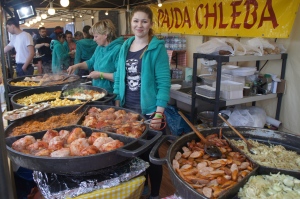
I arrived at the festival about noon on the Friday, and Tomasz very kindly whipped me round the breweries, in his opinion, that should not be missed. Doctor Brew, like Pinta, is a contract operation started by experienced home brewers, Marcin Olszewski and Łukasz Lis, who are based in Wrocław, though their beers are made by Browar Bartek in the village of Cieśle, about 20 miles east, a small brewery that opened in 1992. Doctor Brew began in 2013, which makes it positively ancient in Polish craft beer terms, and like almost all the brewers I tried in Poland, its beers are exceedingly well-crafted and very worth drinking. The Kinky Ale, for example, is made with Equinox, the latest hot American hop, which was released to huge excitement last year, and the beer was filled with deep orangey flavours. As well as a line-up of keg brews on its stall, Doctor Brew also had two Jack Daniels barrel-aged beers, still in their barrels, one a barley wine made with American hops at 10.5% abv, which had spent three months conditioning in the brewery and then four months in the barrel, and the other a Russian Imperial stout. Each was tapped for the first time at the festival – “it was a scary moment,” Łukasz Lis admitted. But for a first attempt at barrel ageing, each was remarkably fine, with huge amounts of coconut and vanilla from the oak and considerable remaining sweetness making for dangeriously drinkable beers.

Next up was a brewery only two months old, Browar Nepomucen, which had been built from scratch in a former bakery in the village of Szkaradowo, just over 30 miles north of Wrocław, by home brewer Jacek Domagalski and the brothers Piotr and Mariusz Musielakówie. Jacek had been a home brewer for eight years, and again this experience has translated with impressive ease into a professional set-up. As well as the usual line-up of beers, Nepomucen (named after a local saint, Jacek told me) brews its own version of the newly revived Polish smoked wheat beer style Grodziskie – Grodzisk Wielkopolski, the town where the style originated, is about 50 miles north of Szkaradowo (and about 80 miles from Wrocław). Nepomucen’s Grodziskie is made from smoked barley malt, smoked wheat malt, and Saaz and East Kent Goldings hops, to a strength of 3.9%, and as my first introduction to the style I thought it very fine.

Soon after I was drinking my second example of a Grodziskie, this one from Grodzisk itself, made from 100% smoked wheat malt, 3.1%, beautifully drinkable, not over-smoky, brewed by a man with the excellent name of Aleksander Chmielewski (chmiel is the Polish for ‘hops’) and his colleagues at the Browar w Grodzisku Wielkopolskim and served in a lovely old-skool Grodziskie glass, which is also embossed on the bottle. Although Grodziskie is an ancient style, this was from an even younger brewery than Nepomucen. Albeit a revival in original brewery buildings, using the original recipe and the original malt, the first “genuine” Grodziskie for 22 years only hit the bartops this month. The brewery is also making three other beers, including a very fine redcurrant-flavoured one and a stronger, more smokey, leathery Bernardyńskie, named for a 16th century saintly monk who allegedly blessed a dry well in Grodziskie that then began flowing again, supplying water for the brewery..
Other beers I noted:
● A double oatmeal stout, aged in Jack Daniels oak barrels again, but only for a few weeks, from the Artezan brewery in Błonie, near Warsaw (and nearer the other Grodzisk, Grodzisk Mazowiecki). This was the first “purpose-built” craft brewery in Poland, as opposed to contract craft brewing set-up, opening in June 2011. The oak had supplied vanilla again, but dialled down compared to Doctor Brew’s beer, with coffee, a touch of chocolate and just a sniff of sourness.
● Hard Bass Stout from the Fine Tuned Brewery in England. Pawel Kubinski, the Polish head brewer at Glastonbury Ales in Somerton, Somerset also produces beers as Fine Tuned, and was in Wrocław to promote his English-brewed beers to fellow Polish drinkers. This is a good 6% abv stout, hopped with British and American hops – Challenger, Northern Brewer, Chinook, Cascade, Fuggles and Citra – and alarmingly smooth, with a nice, slightly liquorish-ish, follow-through, possibly from the rye that is one of the seven grains used. Once again, dangerously drinkable


● Rowing Jack from AleBrowar, another contract-brew collaboration by three home-brewers, led by Michał Saks, in 2012 and using the Gościszewo brewery in the village of the same name in Pomerania, northern Poland, 30 miles from Gdańsk. Many of Poland’s craft brewers have clearly grasped the importance of stylish branding, and AleBrowar’s bottle labels are among the best: individualistic and striking. (The name, incidentally, appears to be a bilingual pun: “ale”, pronounced “ALay”, means “but” or “however” in Polish, and certainly Poles pronounce the name of the operation as “ALayBROOar” rather than “ail-brooar”.)
● A minty wheat beer from Browar Trójmiejski Lubrow in Gdańsk called Kolender z Miętolina, “coriander and mint”, 4.2% abv. This could easily have failed as a product, especially for me, as I’m not fond of mint flavours generally, but it works very well – I really wanted some mint ice-cream with it …
While the Polish craft beer scene is still tiny – Tomasz estimated craft beer sales at only around 1% of total beer sales in the country – it seems clear craft beer will get bigger, with a rush of new brewers into the market, while the rise in the number of beers is being matched by the rise in the number of what in Poland are called “multitaps” [sic], craft beer bars. Thanks to Tomasz, I got to see three new small breweries in and around Wrocław last Saturday morning. One, Widawa, in a restaurant in a small village 20 minutes outside Wrocław, was opened in March 2012, but of the other two, one, Browar Stu Mostów, started only last November, and the other, Browar Profesja, opened its doors just two months ago.
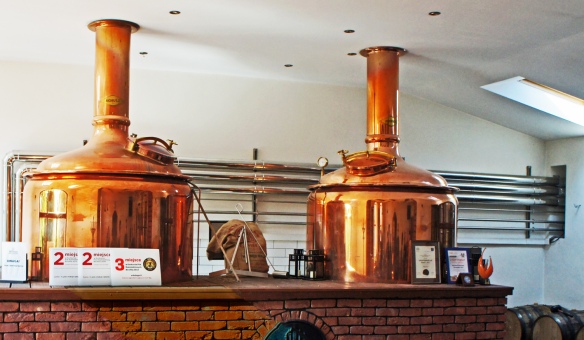
All are already producing excellent, impressive beers. The Widawa brewery, in Chrząstawa Mała (which means “Little Horseradish Pond”, unless Google Translate is lying to me), is run by Wojciech Frączyk, who installed the beautiful copper-coloured brewing kit, plus conditioning vessels, all made by Kaspar Schulz of Bamberg, Germany, at the family restaurant two years ago. The kit being designed for a small version of your standard continental brewing operation, the vessels are a combined mash-tun and brew kettle “heater/boiler”, and a lauter tun – so mash in the heater/boiler, everything into the lauter tun for separation of grains from wort, and back into the heater/boiler for boiling with hops. It was only brewing a standard line-up of beers – pils, hefeweizen – when Tomasz Kopyra turned up on the doorstep to find out what was happening. Tomasz quickly told Frączyk his beers were boring, and persuaded him to brew a stout. Since then the pair have brewed an extensive range of beers, including a coffee pale ale, a wood-aged IPA and a milk stout.
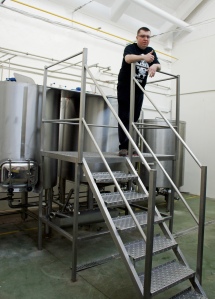
The kit at Profesja in Wrocław, which must be the only brewery based in a former Nazi parachute factory (for the high ceilings) was made and put together by the founder, Michał Gref, and his head brewer, Przemysław Leszczyński, simply because they couldn’t afford to pay large sums to buy ready-fabricated vessels. “Profesja” means “occupation” or “profession”, and the brewery’s bottle labels and beer tap handles all show a dwarf who is following an occupation linked to the name of the beer: Bursztynnik, for example, an amber ale, from the Polish for “amber”, bursztyn, shows a long-bearded amber jeweller holding a fishing net to haul the amber from the Baltic, where it floated onto the shore. (Dwarfs are one of the symbols of Wrocław, from the Orange Alternative, an underground protest movement which started in the city during Communist times in the 1980s, and which sprayed pictures of dwarfs on walls where the authorities had covered up anti-government slogans. On one occasion ten thousand people marched through the centre of Wrocław wearing orange dwarf hats. Now, in commemoration of the Orange Alternative, there are large numbers of small bronze statues of dwarfs found around Wrocław.)
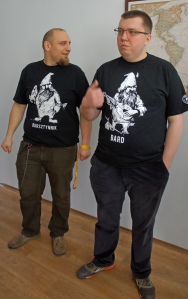
Bursztynnik is hopped with Willamette hops and bittered with Hallertau. Alchemist, a “Brettanomyces IPA”, which has a drawing of a mad-looking dwarf chemist on the bottle labels, is made with Brettanomyces bruxellensi trois, a comparatively mild variety of Brett, fermented very warm, at around 28C/82F, hopped in the kettle with Chinook, Cascade, Galaxy and Saphir and dry-hopped with Citra. It’s the best all-Brett beer I’ve had, with just a touch of “cheesy feet” to give it a character apart from the usual run of assertively hoppy American IPAs. Michał Gref says Profesja “could have brewed for the geeks, but we’re brewing for the people.” Przemysław Leszczyński appears to find this a little frustrating: we found him later competing in the homebrewing contest that is also part of the Wrocław beer festival with brews he admits are too far out for his colleagues at Profesja ever to agree to brew commercially.

In complete contrast to Profesja, Stu Mostów (which means “hundred bridges” – Wrocław sits on the Oder, and the river’s braidings and channels mean there are indeed around a hundred bridges in the city) was founded by a former banker, Grzegorz Ziemian, with backing from ex-banking colleagues, and has a beautiful new 20-hectolitre set-up from the German company BrauKon, erected in a former cinema (high ceilings again) which looks as if it cost a very great deal of money. It only opened in November last year, but again the beers, which include, for example, a chocolate mint FES, are all impeccable. It has three separate brands, WRCLW for “more traditional styles”, Salamander for “new wave” brews, and Art for “collaboration brews” and the like. It has a bar on a mezzanine floor inside the brewery, looking down on the brewkit, which is doing well enough that Ziemian wants to expand by putting a beer garden on the roof of the building.

Perhaps the most surprising brewery I came across, though, was Browar Twigg, from Kraców, which occupied one of the 50 or so stalls at the Wrocław beer festival. If that name doesn’t look Polish, it’s not – Browar Twigg was founded by David Twigg, from Lincolnshire via Cambridge, where he gained a Phd in particle physics (yet another craft brewer with a Phd), practised his home-brewing skills, met an attractive young Polish woman called Paulina Golec, and came out to Poland 18 months ago with Paulina to open a craft brewery. Social media has been very important in promoting the growth of his brewery, David told me – not for the usual reasons, but because Poles found the “twi” sound in Twigg as hard to pronounce as English speakers find “szczy”, until the rise of Twitter, when suddenly they got it. The brewery, the only one now in Kraków itself, is based in part of an old steel works. The kit, from Dave Porter’s PBC in Bury, near Manchester, is 25 hectolitres and many of the beers have “astrophysicy” names, such as Dark Matter, a black IPA, and White Dwarf. “The start was quite hard, but now it’s starting to gain momentum. Poland is in the middle of a beer revolution, people are wanting American-style beers, and I think the market is going to go the way of craft beer in the Western world,” David told me.
Wrocław, pronounced, very approximately, “Vrotswaf”, and around 740 miles almost exactly due east of London, is a very attractive old city in its own right, with some fine medieval buildings (or reconstriucted medieval buildings) to admire and a fascinating history: the city is known to German-speakers as Breslau, it was the biggest settlement in ancient Silesia, and its ruler changed repeatedly: Bohemia around 1000AD, then Poland, Bohemia again in the 14th century, the Hapsburgs of Austria in 1526, and Prussia in 1742. It remained ruled from Berlin for more than 200 years, as Prussia grew into the German Empire and Germany eventually mutated into the Third Reich. But in 1945 Silesia became Polish again, as Stalin shoved post-war Poland violently west, annexing much of the country’s eastern side to the Soviet Union. German speakers fled, and Wrocław and its surroundings were repopulated largely by Poles displaced from what had now become parts of Ukraine, Belorussia and Lithuania. Wrocław is due to be the European City of Culture next year, and its Festival of Good Beer, the biggest in Poland, will be in its seventh year – and doubtless bigger than ever. It will be well worth a visit.
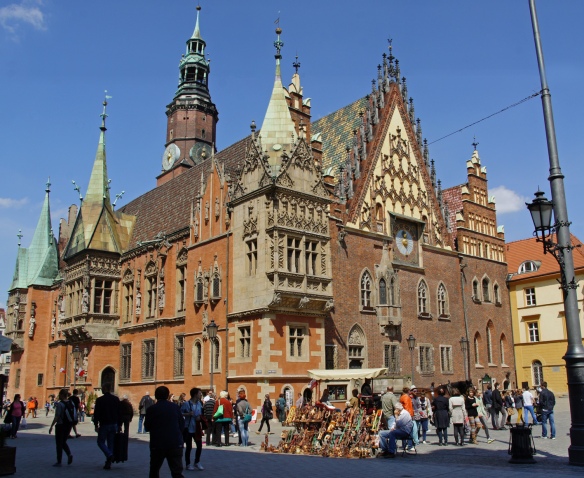

Shouldn’t the headline be “The Polish Craft Beer Scene Is Blowing Up”? It only mentions Simon in the first paragraph.
Trust me, Chad, I’m a lot better at writing clickbait headlines than you.
American Indian (Pale Ale) is a racist term. It should be a Native American Pale Ale.
Indeed. To sit alongside Afro-American IPA.
HI Martyn
Great article as always. Makes me want to go out there. The manager of our bottling plant is Polish so I will share it with him.
Back in 2012 we did a Grodziskie beer called Uppin Smoke (Uppin being an early Prussian word for cloudy” with oak smoked wheat malt. We hopped it with Marynka and Lublin and it was mighty fine!
Pump badge attached.
Robert
“Poland, you may be surprised to learn, is the third largest brewing nation in the EU, and looking to soon overtake the UK and move into second place. It produced around 40 million hectolitres in 2013, from 155 breweries, 96 litres per head per year, up 10.4% in four years, against 42 million hectolitres a year in the UK from 1,490 breweries, 66 litres per head per year, down 7.1% since 2009, and 94.3 million hectolitres a year in Germany, 107 litres per head per year, down 3.8% in four years, from 1,350 or so breweries.”
Martyn, another great post. Those numbers say a lot, as do the wonderful beers coming out of the country. I’m grateful to read about this on Zythophile — we need more good beer writing from this part of the world. Thank you.
More numbers for context:
The Czech Republic produced 19.65 million hectoliters of beer last year (2014), or 187 liters per head per year, up 2.3% on the year, from 300 or so breweries. (Also a country of significant growth: there were only 100 Czech breweries when “Good Beer Guide Prague and the Czech Republic” came out in May of 2007.)
Belgium produced just over 18 million hectoliters in 2013, the most recent figures I can find, or 160 liters per head per year, down about 4% from the year before, from around 200 breweries.
I got to try Lublin to Dublin. What a lovely beer that was. I drank it with a certain wistfulness, knowing that was probably the only time I’d ever get to taste it.